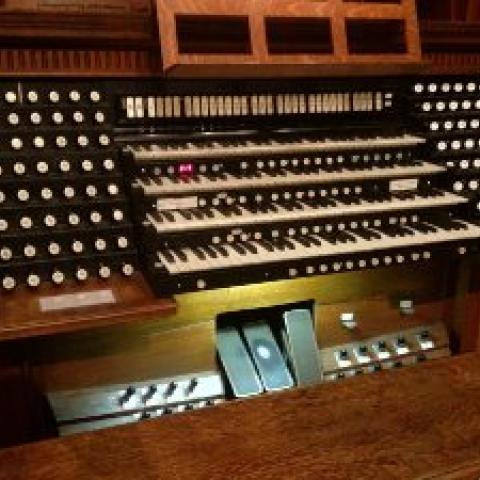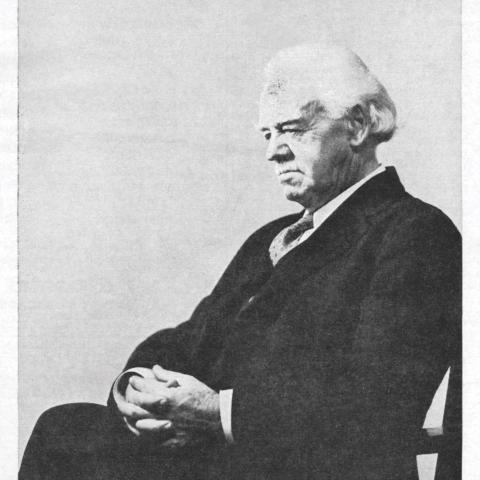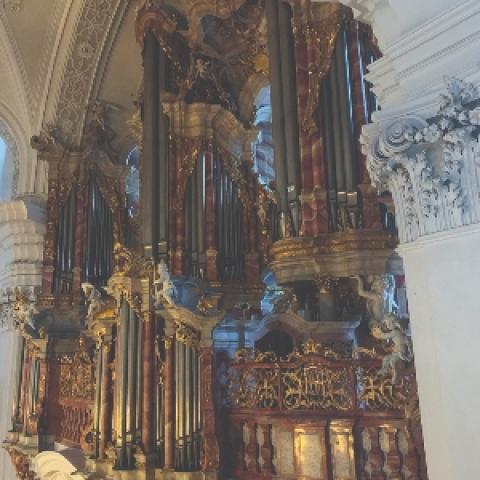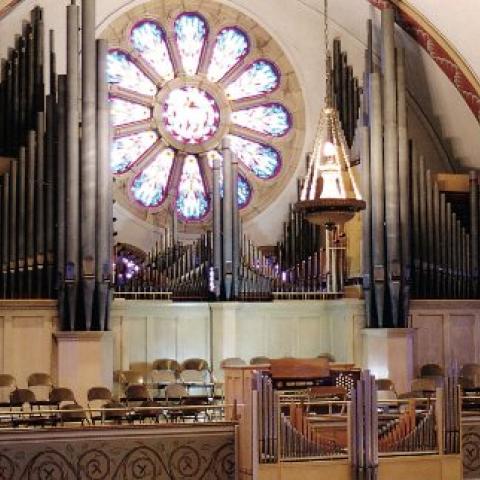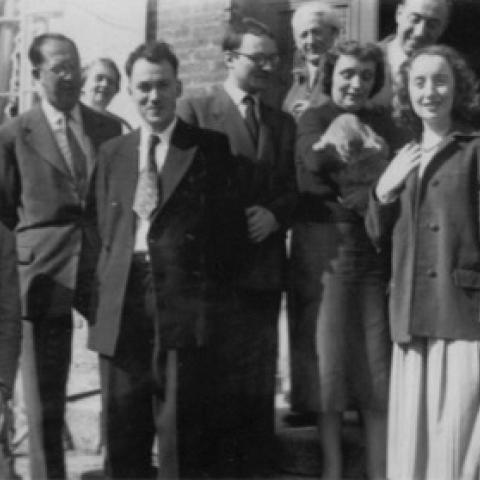David Baskeyfield studied at Oxford University and the Eastman School of Music (studio of David Higgs). The recipient of several first prizes at national and international organ competitions (all with audience prize), and one of few organists based in North America to improvise regularly in recital, he enjoys an international performance career. His latest CD, on the Acis label, Dupré: The American Experience, was recorded on the French-influenced 1932 Aeolian-Skinner organ at Saint Mary the Virgin, Times Square, New York City, and includes the United States premier recording of an unpublished orchestral transcription by Dupré of Dukas’ The Sorcerer’s Apprentice. He is represented in North America by Karen McFarlane Artists, Inc. Connect on Facebook (David Baskeyfield, organist), www.youtube/c/dbaskeyfield, or www.davidbaskeyfield.com.

The Sibley Music Library of the Eastman School of Music, Rochester, New York, houses the collected papers of Rolande Falcinelli, professor of organ at the Paris Conservatoire from 1955 to 1986. A finding aid is available through Sibley’s website (www.esm.rochester.edu/sibley/files/Rolande-Falcinelli-Archive.pdf). Alongside manuscripts, correspondence, and writings by Falcinelli, the collection includes a number of writings by Marcel Dupré, whose association with Falcinelli as mentor and subsequently colleague is well known.
The article below, in Dupré’s predictably meticulous handwriting, is apparently unpublished. It is undated, though from its content can be placed in the late 1950s: Ernest M. Skinner was still alive (he died in 1960), and Dupré appears to make reference to the American innovation of the Doctor of Musical Arts degree, launched in 1953. Further, the American Classic approach to organ reform was sufficiently advanced for Dupré to comment unfavorably on its extremes. Dupré’s first American tour was in 1921, and his observations thus span almost forty years.
The content would admittedly be of less interest if it were not written by a figure such as Dupré. There is very little groundbreaking information here, it is not all entirely accurate—some of his assessments are suspect to the point of spurious—and interest lies principally in these idiosyncratic impressions coming from Dupré himself. Some assertions hint at an agenda: admiration for aspects of American instruments, in particular their action, while unable to refrain from some nationalistic bias in his narrative, and taking a swipe at (likely) Ernest White and possibly even his old friend G. Donald Harrison; and perhaps a grudging desire for France’s pedagogical system and professional organ scene to learn from that of the Americans. At the same time he is sufficiently gushing to be sure to keep his American impresarios happy, presumably the likelihood of further lucrative touring not an insignificant consideration. Overall, he plays two contrasting roles, both of seasoned touring virtuoso and wide-eyed newcomer to a land of plenty. I have annotated many of his claims where it seemed helpful; as to various other assertions, the reader will have no trouble drawing her or his own conclusions. Dupré’s prose is rather dry, and I have attempted to convey this in my translation.
I am grateful to Jonathan Ambrosino for advice and clarification during the preparation of my annotations, and to David Peter Coppen, head of Sibley Special Collections, for his kind assistance with access to the archive.
Editor’s note: subheads have been added to Dupré’s text.
Marcel Dupré: L’Orgue aux Etats-Unis1
North America presents the organist with a treasure trove of experiences and opportunity. There is much to be learned there about different kinds of organ installation, the instrument’s evolution, and trends in its construction; and through these, the very place of the organ within this society.
The visitor is immediately struck by the number of churches scattered about the land. In New York City alone, I count some 1,030 parishes. On arriving in any town, large or small, the visitor is greeted by a main street replete with a prodigious number of towers and steeples. This is down to private endowment, in the form of memorials: when a member of a wealthy family dies, his parents will wish to perpetuate his memory through a public gift—a hospital, library, school, university building or church. In each of these, you will find the finest materials, care, and good taste in the furnishings and, regularly, a beautiful organ.
These churches have capacities varying between five hundred and a thousand seats and, most often, their acoustic is excellent. [sic!]
A number of cities have cathedrals of large dimensions. Their style is usually English Gothic. In Catholic cathedrals the organ is in a rear gallery, as in France. In the Protestant churches, it is situated close to the choir, as in England. These instruments can have as many as a hundred or a hundred and fifty stops.
But it is not only in the churches that fine instruments may be found. There is not one city without numerous concert halls, of various sizes according to location, and always with an organ.
Orchestral concerts are given in halls rarely exceeding eighteen hundred seats. I suppose that this number is the limit if the audience is to hear a concerto soloist properly, or to hear the orchestra with any kind of clarity. Of course, these halls are not just for orchestras—they are generally excellent for chamber music and solo recitals.
The municipal auditorium in each large town is much bigger: four to five thousand seats. These are geared toward oratorios and special concerts by touring virtuosos. As they generally house an enormous organ, they invite famous organists to perform there.
Finally, the “Convention Hall” reaches gigantic proportions, twelve- to eighteen-thousand seats. They are really only used for political rallies or large social events. The acoustic is, as you might expect, terrible, and completely unsuitable for music. Nevertheless, they all have giant organs, which are often excellent.2
The organ in the American education system
But what is perhaps most striking is what we find in universities and colleges: concert halls everywhere, in proportion to the size of the student body. Size is also what determines nomenclature: a college has fewer than three thousand students; a university has more than three thousand and may reach ten thousand. There is nothing more extraordinary than to see these huge rooms filled entirely by young men and young women. They make the most enthusiastic and spirited audiences and also the most attentive. Seven or eight minutes before the concert, these immense halls begin to fill. After the last encore, they empty even faster.
Over the course of their four years of higher education, from age eighteen to twenty-two, these students have the opportunity to hear—and not just once—all the pianists, violinists, singers, chamber musicians, organists, conductors, orchestras, choirs touring the United States. These concerts are paid for out of their tuition fees. They are a part of the education that they receive. It can be seen that this is building a truly elite audience for the future.
High schools (fourteen to eighteen years) also have concert halls and organs. This young audience, likewise attentive and effusive, is quite capable of listening to a serious concert. These are generally given at one o’clock in the afternoon. The concerts are never more than an hour in length.
Finally, numerous private homes have luxurious music rooms whose organs sometimes reach a hundred stops. Their rich owners engage touring artists and invite their friends to come listen to them.3
In a nutshell, there is no place in America that is not equipped to offer a performer a location and instrument with an audience of all ages, always interested and gracious.
And something we can only dream of is the accomplishments and the influence of the “Guild of Organists,” a national union of American organists of more than 6,000 members.4 To become a member requires sitting a two-part examination.5 Each year a convention takes place in one town or another, bringing together the thousands of members. This gives young organists a platform and allows them to make contacts. And within the regional chapters, the members, rather than bitterly defending their own professional interests, discuss questions of organ construction, and recently published organ and choral music, devoting their efforts to developing local interest in the organ. They are very successful in this endeavor.
Young organists get a great deal of help. I could mention one college that has thirty-five [sic]6 little practice organs.
This state of affairs did not happen overnight. It is due to two factors:
1. The existence of a “Music Doctorate,” something unknown in France. In the USA, quite apart from the “Doctor Honoris Causa,” a composer can receive a doctorate for an opera, an oratorio or even a symphony.7 As I see it, we [French] are a long way from this kind of accreditation for music and the arts.
2. More than eighty years of enterprise and progress in organbuilding. France actually plays a part in this story, as I will explain:
American and French organbuilding differences
The electro-magnet, which made possible electric key action, was invented in 18608 by Albert Peschard, organist of the Abbaye aux Hommes in Caen, and a physicist. He built a small house organ to test this (Bouches du Rhône), which was unfortunately destroyed. Two French builders, Debierre and Merklin, built electric action organs. Meanwhile, the invention made it over the Atlantic and, over some forty years, American builders struggled with failed attempts and every possible mishap. Little by little electric action was made reliable. Not ceasing to experiment, these builders improved key and stop action, developed their specifications for flexibility, and made their instruments more and more comfortable.
It was the builders Huntching [sic], Steere, Ernest Skinner (who is still alive today), Kimball, and Austin who worked hardest at this early stage.9
In Canada, the two brothers Clavers [sic]10 and Samuel Casavant, French Canadians from Montreal and personal friends of Aristide Cavaillé-Coll, worked ceaselessly over almost half a century, with magnificent results.
We are forced to admit that the electric organ, though having been invented in Caen in 1860, but developed and established across the Atlantic, and copied slavishly elsewhere, only eventually returned to France, its birthplace, in 1924.11
American builders did not limit themselves to addressing mechanical problems. They strove to create stops of new timbres. No firm was short of the necessary workshops, laboratories, and teams of specialist engineers.12
Naturally, time would tell which of these ideas would be viable and useful, and which would be rejected. Though it cannot quite be said that organbuilding over there is completely standardized, however logical that conclusion would be, a great deal of standardization is nevertheless applied. In spite of this, it is clear that competition between progressive builders sometimes led to extremes, and certain tendencies grew into real infatuations, which can be summarized below.
I would not mention here the so-called “theatre organ,” which can be considered to have disappeared completely with the development of cinema with recorded sound, in 1929, except that we too often forget that this type of instrument actually came about more than 15 years prior to the invention of moving pictures. In effect it was conceived by the English organbuilder Hope-Jones for the University of Edinburgh, around 1885.13 It was Wurlitzer, of Cincinnati,14 that picked up the idea and used it unaltered in the first movie theatres.
The first influence was that of high-pressure stops, from England. There, they built Tubas and Diapasons on up to a meter of wind,15 whereas many of Cavaillé-Coll’s cathedral organs do not go beyond 10 centimeters of pressure. English organists use these stops for a specific purpose: they are made only to solo out the melody of a hymn sung by the whole assembly. They can support and guide thousands of voices, but an experienced organist would never play chords on the stop; the reverberation would be explosive, blinding.16
One curious endeavor was that by Haskell, of the Estey firm,17 who managed to imitate the sound of reed stops with flue pipes. He wished to avoid frequent reed tuning. Up close, the illusion is perfect, though disappears in large rooms at a greater distance from the instrument.
Then came the fads. This was, first of all, string stops, mostly in instruments in private homes. They were, naturally, accompanied by celesting ranks (imitating vibrato). They displaced almost all the other families of tone color. Builders even tried to make mixtures out of very narrow pipes. The sound of those things was particularly acidic. There was also the profusion of various reed stops (oboes, clarinets, etc.), which took the place of foundation stops, making all but special effects impossible.
Finally, after the proper reintroduction of classical mixture stops, which happened around 1923,18 the trend shifted little by little to the almost complete exclusion of foundation stops. I can cite almost unbelievable examples of instruments of more than 90 stops with only six 8′ foundation stops.19 You can judge the aggressiveness of these organs yourself. I find them like drinking bowlfuls of vinegar, and you may quote me on that.
Blended styles and large instruments
But this country is so big, the opportunities so great, and the different schools of thought so numerous that everything ends up circulating in an unlimited expansion of ideas. There is room for these different instruments to coexist and last peacefully, for the most part.
Most organbuilders are still guided by common sense. And they build countless instruments of rich and beautiful palettes of sound, perfectly adapted to their location. A list of names, even abridged, is impossible here. I shall simply mention:
1. The cities richest in fine organs: New York, Philadelphia, Washington, Boston, Chicago, Detroit, Cleveland, Cincinnati, St. Louis, Denver, Salt Lake City, San Francisco, Los Angeles, Columbus.
2. The best endowed universities: Yale, Princeton, Columbia, Harvard, Chicago, Minneapolis, Los Angeles.
I would also mention, in Canada: Montreal, Quebec, Toronto, Winnipeg, Vancouver.
The giant organs in America intrigue French organists. The questions are often the same: “Are all these stops really necessary?” “Can they all really be different?” My answer is that the massed effect and depth of sound produced by these instruments is astonishing. Then, on playing them, you realize that every stop does have its own characteristic effect. Each family of stops on each keyboard presents a gradation of intensity and volume, which allows an almost infinite subtlety in combining stops. Think of a great box of pastels, where each color contributes its own shade and hue to the whole spectrum.
Among these immense instruments, the strangest, and also the biggest in the world, is the Wanamaker of Philadelphia. It has 451 stops, around 32,000 pipes.20 There is no borrowing or duplexing, even on the pedals. It has six manuals, but actually consists of eleven enclosed divisions that can be assigned by stopkeys to whichever manual you wish. It has 48 general pistons, adjustable at will; having registered a whole recital in advance, the touch of a thumb on one of the buttons under the manuals will bring on or take off stops instantly to give the prepared combination.
It seems that the era of the building of these giants is over. They remain, nevertheless, as witnesses to a period where material possibilities seemed limitless. Today we can confess that, though interesting, they are, happily, not necessary to art.
America is a land of surprises, and you will walk from discovery to discovery, all of them reflecting the diversity of thought and opinion. The European stands astonished before this rampant and incessant activity, this prodigious amount of production, which at first glance just seems effortless. Whoever goes there and has the fortune to be initiated into the organ world in its various forms, can only long for such potential, such will, and such drive in his own country.
Translation © David Baskeyfield, 2019
Notes
1. Roland Falcinelli Archive, Sibley Music Library, Eastman School of Music, Rochester, New York, Box 33/1.
2. Data on original seating capacity are hard to come by and modern building and fire codes render current occupancy irrelevant to making a judgment on Dupré’s figures. For example, Boardwalk Hall now lists a maximum seating capacity of 14,770, a substantially smaller number than its original 41,000.
3. Currently living in Rochester, I am duty bound to note George Eastman’s Aeolian
organ of 132 ranks at its completion; the Eastman House’s collection of rolls includes a number recorded by Dupré at the Aeolian Hall studios, New York City, and from correspondence archived at the Eastman House we can see that Dupré played for George Eastman at least twice, in December 1923 and 1924.
4. The Story of the American Guild of Organists, by Guild founder Samuel A. Baldwin, published in 1946—the AGO’s 50th anniversary year—describes membership as “well above 6,000.” That figure in itself, though, does not really help much in pinning down a precise date of Dupré’s article.
5. This is not accurate; examination has only ever been required for certification [Baldwin, 1946].
6. In mentioning such an obviously inflated number, Dupré may have hoped to put pressure on the Paris Conservatoire or the American Conservatory at Fontainebleau. His interest in the distinctly American concept of the practice organ (unknown to European schools at that time) is neatly illustrated by a pencil sketch of the plan of the Eastman School organ practice rooms with a note of each room’s instrument, also in the Falcinelli Archive.
7. This seems likely to be a reference specifically to the DMA, the academic study of music at degree-conferring institutions being long established in Europe. Such figures as Mendelssohn, Liszt, and Brahms had been named honorary Doctors of Music, the title “Dr. Brahms” being frequently used pejoratively by his contemporaries to belittle him as a stolid, academic composer. The DMA was developed principally by Howard Hanson (dean of the Eastman School of Music and himself the recipient of an honorary doctorate in 1925). The accreditation body, the National Association of Schools of Music, approved the degree in 1952, it was offered in 1953, and the first degree was conferred in 1954.
8. At the Paris Exposition of 1855, Stein and Son, manufacturers of reed organs, exhibited an organ operated by electromagnets applied directly to the pallets. Sufficient current could not be generated to operate the larger pallets reliably. In 1861 Peschard worked with Charles Barker on applying electromagnets to Barker’s pneumatic motors; Peschard’s electro-pneumatic system was patented in 1864. It was famously used in the organ for St. Augustin, completed 1866, but proved unreliable, principally owing to the strong current required for magnets operating on the motors directly. This tended to magnetize the electromagnets permanently, causing ciphers. The large wet-pile batteries required to generate such strong current were costly and required frequent replacement, and there was a danger of splashing mercury from the contacts during staccato playing. In 1898 Cavaillé-Coll rebuilt the instrument with Barker machines [Fenner Douglass, Cavaillé-Coll and the French Romantic Tradition, New Haven, Yale University Press, 1999].
9. Dupré’s characterization is misleading. It was Skinner, working at the time for Hutchings, who produced the first electric action (1893) bearing that company’s name, prior to founding his own company [Ambrosino, A History of the Skinner Company]. Dupré also omits the contribution of Robert Hope-Jones, who was associated in America with Austin (1903–1904) and Skinner (1905–1906). Skinner had first met Hope-Jones in England in 1898. Later in life professing dislike of Hope-Jones’s instruments, he nevertheless must have been impressed by their action: “I believe you were the first to recognize the importance of a low voltage of electric action, and that the world owes you its thanks for the round wire contact and inverted magnet.”
10. The builder’s Christian name is Claver.
11. Dupré is being coy. No instrument of milestone status was completed or dedicated in 1924; 1924 was the date of the infamous installation of the electric blower at Notre Dame, but “electric organ” clearly refers to key action. The year is almost certainly a reference to two events.
In 1924, Auguste Convers assumed directorship of what had been the Cavaillé-Coll company, though the firm had yet to produce a new organ. The same year, E. M. Skinner visited Paris for the second time (the first was in 1898 when Dupré would have been twelve years old) and Dupré might just be taking the rare liberty of a rhetorical twist to conflate electric playing action with the person of Skinner. Dupré spoke extremely highly of Skinner’s instruments; his admiration of their action and playing aids is well documented. Arthur Poister, the legendary pedagogue and one of Dupré’s first American students, recalled that “had it not been for [Dupré’s] experience with American organs with their easier manual and pedal actions, he could not have written some of the music he wrote. His entire concept of tempos and playability was changed by his first American experience.” In Dupré’s own words, “mechanical improvements on American organs are far in advance of European . . . I believe that American inventiveness and ingenuity will within the next few years bring about advances as yet unheard of.” Mentioning specifically the year of Skinner’s personal visit might suggest a hint of proprietorial pride: Michael Murray [Marcel Dupré, The Work of a Master Organist. Boston: Northeastern Music Press, 1985, p. 132] writes that Dupré had gone so far as to convey to him in a personal conversation that, during the mid 1920s, he had “helped Skinner introduce electricity” to organs in Paris. This is an extraordinary claim and not without smugness. Skinner recounted his 1924 trip in Stop, Open and Reed, his company’s house publication, volume 2 (1924). Of Dupré, he writes, “M. Marcel Dupré is a vitally alive musical personality. His interest in the ancient organs is great but he is equally interested in the modern organ. He does not glorify the past to the disparagement of the present. Our American Orchestral Color has received the entire approval and indorsement [sic] of M. Marcel Dupré. He leaves no room for doubt in his admiration for it. His use of it will make a further contribution to organ literature unless I am very much mistaken.”
Skinner found the Cavaillé-Coll factory “absolutely destitute” of modern machinery. “Everything done by hand. No electric or tubular actions . . . There is much prejudice in France against doing anything new.” Elsewhere, “The French Organ is a work of art and a great one, tho [sic] according to our present day standards very crude mechanically . . . The inconvenience of the French console is inconceivable.”
At the time of Skinner’s trip, Convers was new in his position, having only recently succeeded Charles Mutin. Skinner liked Convers and considered him a good man to bring the company out of the dark ages. In the event, the electric action instruments produced by Manufacture d’orgues Cavaillé-Coll, Mutin, A. Convers et Cie. proved unreliable and the company was bankrupt by 1928. In noting the year 1924, Dupré is probably simply taking credit for introducing Skinner to Convers at the factory, Skinner presumably being encouraging of Convers’s novel path. In any case, Skinner himself takes no credit for any substantive involvement with electric action in French instruments. Given the tone of Stop, Open and Reed, had this been so, he certainly would have.
12. This translation may be drier than Dupré intended to convey. His term here is ingénieurs spécialisés. The noun ingénieur translates directly as engineer, but the association of the root with the quality of inventiveness might be borne in mind: the verb ingénier means to strive; the noun ingéniosité means ingenenuity.
13. This is misleading. Hope-Jones’s earliest work was the 1887 rebuilding, with electric
action, of the organ at the church of Saint John, Birkenhead, where he was organist and choirmaster. In 1897 he completed a total rebuild of the 1875 Hill organ in McEwan Hall at the University of Edinburgh: though unquestionably a glimpse of things to come and indeed decked out with such novelties as Tibia Clausa, Diapason Phonon, Kinura, and Diaphone—high pressure, unblending stops of extreme scale that would later find their proper place in the Hope-Jones Unit Orchestra—it could no more properly be characterized as a theatre organ than the Worcester Cathedral rebuild of the previous year.
14. The Rudolph Wurlitzer Company started in Cincinnati in 1853 but relocated to North Tonawanda, New York, in 1908.
15. Dupré’s characterization is not quite right and more than a little hyperbolic. Although Hill got the ball rolling as early as 1840 at Birmingham Town Hall with his celebrated Grand Ophicleide on 15′′, high-pressure reed voicing was developed by American builders considerably beyond that of the English. A metre is 39′′ in Imperial units; Harrison and Harrison tubas were typically voiced on 12′′ to 15′′. At Salisbury (1877), Father Willis’s Tuba was on 18′′; a generation later, Harrison and Harrison’s at Ely (1908) were still on [only] 20′′. Liverpool Cathedral (1912–1926) and Westminster Cathedral (1920–1932), both by Willis III, with whom Dupré and Skinner were associated, do have Tubas on 30′′ (and Liverpool has a Tuba Magna on 50′′), but they are the exception, and by that point Willis III and Skinner were long acquaintances. We can be grateful that Hope-Jones’s proposal at Worcester to mount a Tuba over the Canons’ stalls on 100′′ was not carried out.
16. A bad demonstration by an enthusiastic incumbent?
17. Both William Haskell and his father Charles worked for the Roosevelt firm. When his father established his own firm, C. S. Haskell, William left Roosevelt to work with his father; he subsequently established William E. Haskell Co. of Philadelphia in 1901. That firm was acquired by Estey, whereupon William became superintendent of the Estey pipe division.
18. This may be a reference to Skinner’s second visit to England in 1924, where he met Henry Willis III. The trip is considered a turning point in Skinner’s tonal philosophy, whereupon he reevaluated the place of quint mixtures in the ensemble and began drastically expanding his chorus work.
19. An extreme example might be Ernest White’s essay at St. George’s Episcopal Church, New York City (Möller, 1958): of 96 ranks, two are unison principal stops.
20. Dupré exaggerates only slightly. Expanded 1911–1917 and 1924–1930, the Wanamaker organ now has 464 ranks, 401 stops, and 28,750 pipes.

